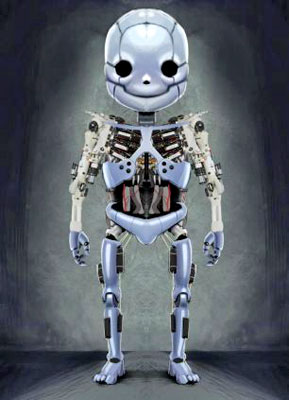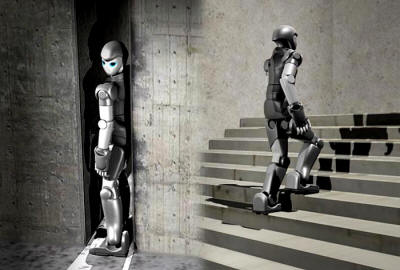|
from OccupyCorporatism Website
The Artificial Intelligence Lab (AIL) at the University of Zurich is the home to a 1.2m tall robot named Roboy.
He is modeled after the anatomy of a 2 - 3 year old child and uses artificial “tendons” to move about. Researchers hope to have Roboy operational by 2013 and unveiled at the Robots on Tour event in Zurich.
The construction of a tendon-modeled system will allow Roboy to move with fluidity as a human. Dr. Rolf Pfeifer, professor and lab director, designed the construction principles of Roboy.
Calling the technology “soft robotics”, the project demanded the assistance of scientists and engineers to create tendon-controlled motor technology that emulates the flexibility of fibrous collagen tissue attached to muscles and bone in humans.
Advancements in synthetic skin for prosthetics have given way to the same technology being utilized for AI. Experiments in “epidermal electronics” have produced a skin-like creation that is self-healing.
Zhenan Bao, chemical engineer at Stanford University has developed a polymer that incorporates nickel atoms that allows electrons to “jump” between the mental atoms. The polymer is sensitive to pressure and tension. The jumping produces the sensation of feeling.
And when the “skin” is cut, it regenerates and retains 98% of its original conductivity.
Soft robotics refers to the technological development of robots that:
Trusting that AI robots will become partners to humans in the future, the research must mimic biology.
A robot’s brain is a microprocessor, its eyes are cameras, its ears are microphones and muscles are electrical motors that sit in joints. Gathering inspiration from biological machines is the goal; to copy nature in robotic form.
Pfeifer believes that “next-generation robots” will have “a high behavioral diversity” as inspired by biology and be similar to humans.
Roboy is in its construction phase. A face is being developed as well as soft skin to cover its body and make the robot more palatable to the public.
Roboy is slated to become a standard and blueprint of future AI. Over 40 engineers and 14 project partners have come together with the hope of making Roboy commercially accessible. As a service robot, Roboy would be expected to make life more convenient for humans.
Roboy would share their living space, be friendly and accommodating as to remain important to daily life.
Science fiction is becoming a reality with the introduction of service robots that is expected to “influence human-robot interaction”.
These robots will be autonomous, mobile and perform functions humans may not want to do in the future.
Bill Gates has contributed to the concept that there should be “a robot in every home.” Citing the 2004 Defense Advanced Research Projects Agency (DARPA) Grand Challenge, Gates supports the robotic industry to bring AI devices to the forefront of future consumerism.
The Pentagon’s DARPA program has been perfecting autonomous robotic systems for years under the leadership of a panel of defense experts and senior Pentagon officials.
The goal is to create robots that can think for themselves once they have their “orders” and take “uncontrolled action”.
As of now,
The Battlefield Extraction-Assist Robot (BEAR) is a humanoid design that helps soldiers.
Vecna Technologies initially created BEAR with funding from the US Army. BEAR is intended to pick up soldiers and carry them to safety in war-like conditions. Vecna is now looking to other applications for BEAR such as “high value activities” such as loading and unloading cargo.
Because of the risks involved in rescue aid workers and human response teams, DARPA awarded Boston Dynamics, Inc. a $10.9 million contract to manufacture humanoid robots that are bi-pedal, built like humans and have a sensor head with on-board computing capabilities.
Completion of the project is expected for August of 2014.
In the wake of Sandy, the Pentagon has requested that a team of “rescue robots” be engineered in time for the next “natural disaster”.
The new DARPA Robotics Challenge is putting out the call for a synthetic force that can be designed for autonomous thought; yet mitigate the risk to human life when performing a rescue mission.
The International Relations and Security Network (ISN) in Zurich explains that there should be international governance over autonomous military robots (AMR).
The strength and lethal force of AMR,
The UN has been called to consider the negative applications of AMR to peace, national security and civilians with recommendations for “substantive policies and restrictions.”
Autonomous robots have given military advantage of success which is a strong motivator for defense agencies.
Noel Sharkey, professor of Artificial Intelligence and Robotics at Sheffield University warns that globalist think-tanks and the rise of the military industrial complex will culminate in the creation of synthetic armies that could turn on their creators should they be equipped with autonomous thought programming.
Sharkey explains:
The Human Rights Watch (HRW) has released a report entitled “Losing Humanity - The Case Against Killer Robots” which cautions that autonomous synthetic armed forces lack conscious empathy that human soldiers have and could perform lethal missions without provocation.
Autonomous synthetic robots used as weapons cannot inherently conform to,
The HRW report states:
Indeed, the responsibility factor is questionable on a legal stand-point because who is ultimately responsible for the actions of a synthetic armed force robot?
|



